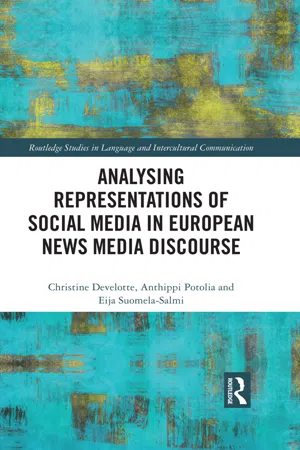
Analysing Representations of Social Media in European News Media Discourse
- 264 pages
- English
- ePUB (mobile friendly)
- Available on iOS & Android
Analysing Representations of Social Media in European News Media Discourse
About This Book
This book explores representations of social media in European media discourses across different socio-historical contexts, demonstrating how such analysis can illuminate the tension between global and local in media discourses in today's globalised world.
The volume draws on data from a trilingual corpus from different editions of the free daily Metro from Finland, France, and Greece spanning a five-year period, with a focus on Facebook and Twitter. Adopting a French discourse analysis approach, which takes as its point of departure the notion of "discourse as the social practice of representing", the book integrates qualitative and quantitative analyses to investigate the social and political role depictions of social media play in specific socio-historical contexts. This approach brings to the fore both commonalities and differences in the popularity of specific platforms and coverage of specific news topics and hot-button issues. In so doing, the volume elucidates the ways in which global practices become integrated and immersed into local contexts, offering avenues for future research on social media in news discourses.
This book will be of interest to scholars in applied linguistics, intercultural communication, discourse analysis, media studies, and cultural studies.
Frequently asked questions
Information
Part 1
Theoretical Framework and Methodology
1 Discourse Analyses and Key Research Concepts
1.1. Insights in Two Analytical Perspectives of Discourses
1.1.1. The French School of Discourse Analysis
The principles of structuralism of Harris (USA) are applied with caution; the enunciative conception analysing indices (formal markers) of personal and temporal deixis, aspect and modality (in line with Bally and Benveniste) is adopted to study how enunciators use language in communication; a certain predilection for text corpora of historical and political discourse, preferentially left wing, produced in institutional settings constraining heavily enunciation ; an effort to articulate the relationship of language use and history or social history, that is with ideologies and dialectic materialism.(Peytard and Moirand, 1992: 42)2
Discourse analysis became to signify a sort of psychoanalysis applied to texts. In order “to unravel the unexpressed in the text”, it had “to be related to another text”, that of ideology, “necessarily absent from the first one”. This is akin to psychoanalysis, able to decipher “in the innocence of speech and listening” the depth to be assigned to another, to a completely different discourse, the discourse of the unconsciousness” […].(ibid.: 117)
1) certain preference for corpora that are more or less constrained (unlike conversation analysis for example) and for corpora with a historical interest, 2) the emphasis laid on analysing discursive phenomena also as linguistic entities and not only their discursive functions, 3) privileged relation with the theory of linguistic enunciation, 4) importance of interdiscourse, 5) reflection on the ways the speaking Subject inscribes himself in discourse.(Charaudeau & Maingueneau, 2002: 202)
1.1.2. Critical Discourse Analysis vs. French Discourse Analysis
Table of contents
- Cover
- Half Title
- Series Information
- Title Page
- Copyright Page
- Table of Contents
- General Introduction
- Part 1 Theoretical Framework and Methodology
- Part 2 Contextualisation of and Macro-Level Analysis of the Object of Study
- Part 3 Social Media Representations in Three Different Discursive Spaces
- General Conclusion
- Bibliography
- Appendix A. Metro Editors – Interview Questions
- Appendix B. Titles with Keywords “Facebook” and “Twitter” in the Three National Corpora (2007–2011)
- Index (Author and Keyword)